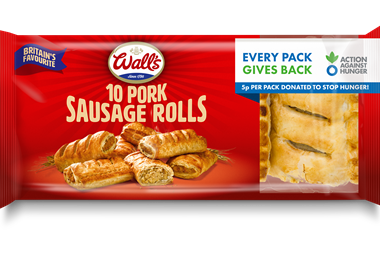Frozen launches the big fightback against the rise of chilled.
Manufacturers of frozen food have had to battle hard to combat the rise in popularity of chilled products in recent years, with shoppers often believing frozen products are inferior from a health perspective. Manufacturers are the first to admit the whole category has endured a tough year in 2005.
Companies such as Birds Eye have had to drum home to consumers that they are offering healthy frozen products; other big forzen foods companies have been forced to downsize. Company chiefs, though, are adamant frozen food is in no danger of disappearing off our shelves and remains a huge opportunity in which retailers must continue to invest.
Category director at Unilever John Farrell says: “Although it’s been quite a tough year for the frozen category, with value sales slightly down, frozen is still a massive category, with 98.9% of people still buying frozen food within a given year. There are a lot of customers out there for retailers to grab. It’s true we’ve seen a significant growth in chilled in recent years but we firmly believe frozen is a category for the future as it is a natural way of keeping food fresh.”
Farrell says Unilever has had to communicate its values on its Birds Eye products more clearly. The company’s Fight for Real Food campaign, which has seen levels of salt, fat and sugar reduced, is an example of this. “There is a need to gear products from both a health and convenience point of view. The category will win the fight against chilled with innovation and by reinventing itself,” says Farrell.
“Frozen is clearly a category that performs a vital role in society. However, we need to move forward. Retailers should be investing in the category and should take faith from the fact that we are doing the same,” he adds.
A number of smaller companies have latched on to the gap created by the departure of some of the major players. Jeremy Garrett-Cox, from Leathams Foods, believes the frozen category has to communicate well with both retailers and shoppers. He says: “Our approach is to keep it simple: We want people to see our products so we don’t clad them in cardboard packaging. People want to be able to see the food they are buying.”
Garrett-Cox believes there is still a positive outlook for the category and adds: “I believe there is a hugely bright future ahead. To ensure this though, we must continue to reinvent, and our products offer us a huge opportunity to do that.
“The main thing the industry is being forced to do is improve the quality of food available. It is about getting the word out. Some retailers need to have a good look at what is for sale at the bottom of their freezers and judge whether it is working.”
NOT JUST FOR THE SUMMER
Sales of ice cream in c-stores need not dwindle in the winter. According to the figures, it’s probably worth thinking twice before removing your ice-cream freezer from the shop floor.
Richmond Ice Cream marketing director Kate Needham says: “Last winter more than 40% of ice cream sales in the convenience sector took place between October and March, with sales during the week before Christmas alone worth more than £12m. Ice cream is a profitable year-round category and more than half the UK population buy ice cream during the winter months.
“Our advice is to not put freezers away at the end of the summer but fill them with both new products and proven fast sellers to boost ice cream sales during the winter. The half-price and multi-buy promotions also enable retailers to keep prices competitive.”
Manufacturers of frozen food have had to battle hard to combat the rise in popularity of chilled products in recent years, with shoppers often believing frozen products are inferior from a health perspective. Manufacturers are the first to admit the whole category has endured a tough year in 2005.
Companies such as Birds Eye have had to drum home to consumers that they are offering healthy frozen products; other big forzen foods companies have been forced to downsize. Company chiefs, though, are adamant frozen food is in no danger of disappearing off our shelves and remains a huge opportunity in which retailers must continue to invest.
Category director at Unilever John Farrell says: “Although it’s been quite a tough year for the frozen category, with value sales slightly down, frozen is still a massive category, with 98.9% of people still buying frozen food within a given year. There are a lot of customers out there for retailers to grab. It’s true we’ve seen a significant growth in chilled in recent years but we firmly believe frozen is a category for the future as it is a natural way of keeping food fresh.”
Farrell says Unilever has had to communicate its values on its Birds Eye products more clearly. The company’s Fight for Real Food campaign, which has seen levels of salt, fat and sugar reduced, is an example of this. “There is a need to gear products from both a health and convenience point of view. The category will win the fight against chilled with innovation and by reinventing itself,” says Farrell.
“Frozen is clearly a category that performs a vital role in society. However, we need to move forward. Retailers should be investing in the category and should take faith from the fact that we are doing the same,” he adds.
A number of smaller companies have latched on to the gap created by the departure of some of the major players. Jeremy Garrett-Cox, from Leathams Foods, believes the frozen category has to communicate well with both retailers and shoppers. He says: “Our approach is to keep it simple: We want people to see our products so we don’t clad them in cardboard packaging. People want to be able to see the food they are buying.”
Garrett-Cox believes there is still a positive outlook for the category and adds: “I believe there is a hugely bright future ahead. To ensure this though, we must continue to reinvent, and our products offer us a huge opportunity to do that.
“The main thing the industry is being forced to do is improve the quality of food available. It is about getting the word out. Some retailers need to have a good look at what is for sale at the bottom of their freezers and judge whether it is working.”
NOT JUST FOR THE SUMMER
Sales of ice cream in c-stores need not dwindle in the winter. According to the figures, it’s probably worth thinking twice before removing your ice-cream freezer from the shop floor.
Richmond Ice Cream marketing director Kate Needham says: “Last winter more than 40% of ice cream sales in the convenience sector took place between October and March, with sales during the week before Christmas alone worth more than £12m. Ice cream is a profitable year-round category and more than half the UK population buy ice cream during the winter months.
“Our advice is to not put freezers away at the end of the summer but fill them with both new products and proven fast sellers to boost ice cream sales during the winter. The half-price and multi-buy promotions also enable retailers to keep prices competitive.”























No comments yet